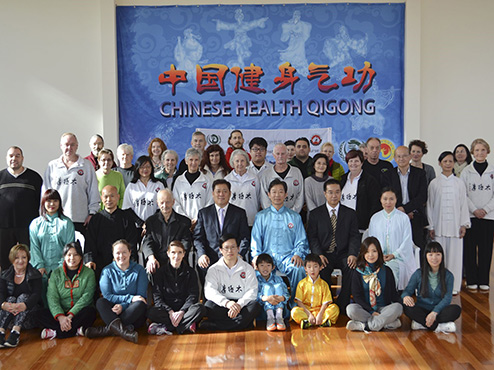2018-03-19
此处的“阴阳双鱼”指的是“双鱼悬阁”势。 此处的“象”,是指太极图之四象。此四象在八卦中指的是少阳、老阳、少阴、老阴;在时令上指的是春、夏、秋、冬四季;在方位上指的是东、西、南、北四方。
详情
2018-03-19
详情
2018-03-16
The Chinese word “Wu” (namely “dancing”) can be a verb, which means “to shake”, while “Dao” means “to exercise with lower limbs”. Therefore, “Wu Dao” means “to shaking your arms and moving your legs to get exercises for the whole body”. The pictures on the pot show that the dancers are taking a whole body exercises in a quick rhythm and with a large range of movements. If the dancers in the pictures are the patients, then it coincides with the account about using dancing to cure illnesses in the Lush • Chennai and Lu Shi.
详情
2018-03-16
Meanwhile, the meditation and be wordless are quite essential for the practice of Health Qigong. It would be the best time to enter the meditation state when achieving the integration of three regulations.
详情
2018-03-16
同时,静神寡言对练功入静至关重要。习练健身气功在调身、调心、调息达到合一的状态时,必然是练功入静的好时机,此时的静,更多地表现为形体在运动、呼吸在运行、心神则是在深深地守静,而不需要语言的表达...
详情
2018-03-16
“舞”作为动词,有“摇动”的意思;“蹈”古人谓“道也,以足践之如道”;“舞”“蹈”连用前者着重说明手(上肢)的摇动,“蹈”主要说明足(下肢)的运动,而“手舞足蹈”的上下肢运动,必然会带动全身的运动。舞蹈纹彩陶盆的画面展示的也正是快节奏、大幅度的全身性运动。如果湿病患者作此运动,利水祛湿,运动筋骨,活络关节等的作用,与《吕氏春秋》、《路史》的记载也非常吻合。
详情
会员协会链接
亚洲
非洲
北美洲
南美洲
欧洲
大洋洲
以-中武术文化中心
蒙古国健身气功协会
斯里兰卡健身气功协会
伊朗健身气功协会
印度气功协会
全日本健身气功国际联盟
全日本导引养生功联盟
日本健身气功普及协会
日本健身气功协会
全日本健身气功联合会
日本练功十八法协会
导引养生功日本总本部
中国香港健身气功总会
中国上海市健身气功协会
中国北京市健身气功协会
中国云南省健身气功协会
中国重庆市健身气功协会
中国湖北省健身气功协会
中国河南省健身气功协会
中国山东省健身气功协会
中国江西省健身气功协会
中国安徽省健身气功协会
中国江苏省健身气功协会
中国健身气功协会
中国内蒙古健身气功协会
中国福建省健身气功协会
中华台北健身气功总会
阿联酋迪拜精武会
新加坡气功十八式协会
大韩传统仙术协会
马来西亚健身气功总会
中国澳门健身气功总会
国际健身气功联合会版权所有 备案:京ICP备15050301号
京公网安备 11010102002746号
